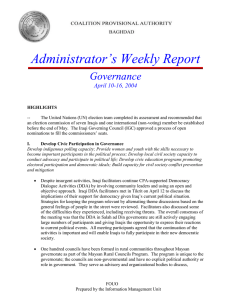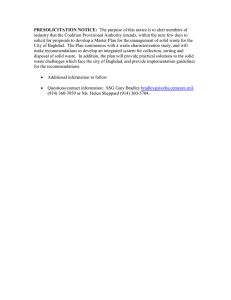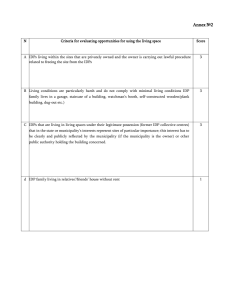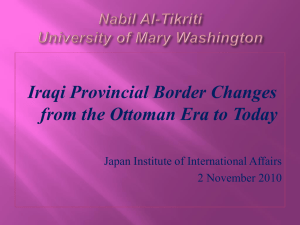UNHCR Second Rapid Assessment of Return of Iraqis from
advertisement
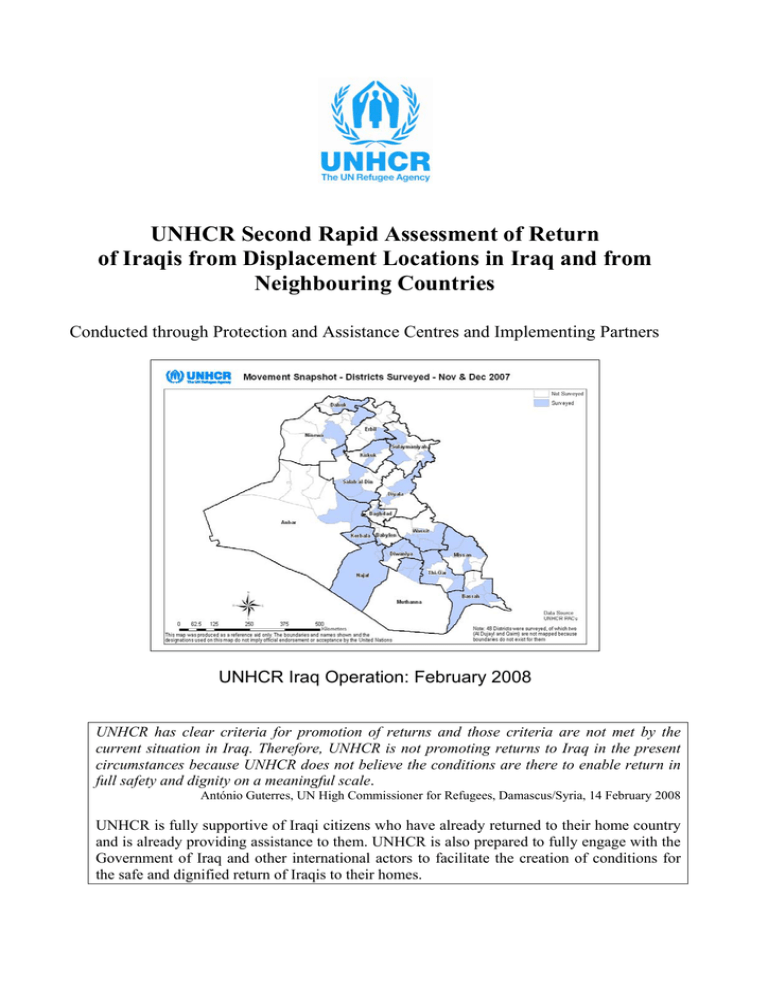
UNHCR Second Rapid Assessment of Return of Iraqis from Displacement Locations in Iraq and from Neighbouring Countries Conducted through Protection and Assistance Centres and Implementing Partners UNHCR Iraq Operation: February 2008 UNHCR has clear criteria for promotion of returns and those criteria are not met by the current situation in Iraq. Therefore, UNHCR is not promoting returns to Iraq in the present circumstances because UNHCR does not believe the conditions are there to enable return in full safety and dignity on a meaningful scale. António Guterres, UN High Commissioner for Refugees, Damascus/Syria, 14 February 2008 UNHCR is fully supportive of Iraqi citizens who have already returned to their home country and is already providing assistance to them. UNHCR is also prepared to fully engage with the Government of Iraq and other international actors to facilitate the creation of conditions for the safe and dignified return of Iraqis to their homes. 2 Executive Summary • As of 31 December 2007, 1,268,873 persons have been recorded as being internally displaced after the escalation of violence in the aftermath of the February 2006 Samarra bombing. In addition, 190,146 persons have become internally displaced between 2003 and 2005. 1 The total estimated number of IDPs since March 2003 is therefore 1,459,019 individuals. As of September 2007, UNHCR’s partners have reported that fewer Iraqis are being internally displaced each month compared with preceding months, mostly due to sectarian homogenization at the governorate, district and neighbourhood level, as well as the improved security situation in parts of Baghdad and Anbar. • From October to December 2007, an increase of 69,382 persons was recorded. This is due to fresh displacement, time delays between displacement and registration of IDPs, improved Ministry of Displacement and Migration (MoDM) registration procedures and increased IDP access to these procedures. 2 • UNHCR estimates that there are two million Iraqis displaced to other countries in the region including 1,400,000 in Syria and 450,000-500,000 in Jordan. 3 • Actual numbers of IDP and refugee returnees are currently uncertain. According to the latest figures released by MoDM, nearly 6,000 IDP families returned to Baghdad between February 2007 and December 2007. MoDM estimated on 26 November 2007 that approximately 30,000 families had returned from abroad in 2007. The Iraqi Red Crescent Society (IRCS) estimated that around 46,000 individuals returned to Baghdad between 15 September and 27 December 2007. 4 • Data analyzed in this report include the movement of 3,241 IDP and 1,894 refugee families recorded in November 2007 as well as the movement of 346 IDP and 313 refugee families recorded in December 2007 in various locations in Iraq. 5 • Iraqi and Syrian authorities report that more individuals crossed into Syria coming from Iraq than vice versa at the Al-Waleed/ Al-Tanf border crossing during the last week of January and first week of February 2008. Looking, however, at the period of 1 August 2007 to 6 February 2008, the number of individuals crossing into Iraq coming from Syria has been higher than the number of persons crossing in the opposite direction. 6 • Return movements are mostly happening to areas which have become ethnically/religiously homogeneous. Returnees mostly return to those neighbourhoods/districts/governorates under control of members of their sect. To date, only a few families returned to areas under control of another sect.7 • No members of minority groups (e.g., Christians, Sabaean-Mandaeans and Yazidis) have been reported to be among the returnees. 8 • What is reported as return includes secondary displacement. Difficulties in the place of displacement and impossibility of returning to their homes are often the cause for repeated movements of displaced persons. 9 1 See Section 2. Ibid. 3 Ibid. 4 Ibid. 5 See Section 1. 6 See Section 10. 7 See Sections 3 and 8. 8 See Section 8. 9 See Section 6. 2 3 • The main impediments to return in safety and dignity are ongoing sectarianism by groups in control of a governorate, district or neighbourhood as well as destroyed or occupied properties. 10 Many houses left behind by internally displaced persons (IDPs) were occupied by other IDPs. 11 • Limited access to basic services does not as such impede returns. However, returnees are in need of basic services in addition to non-food items, food, shelter and employment. 12 • UNHCR is fully supportive of returnees and is already providing assistance to them. 13 • UNHCR remains concerned about the prevailing level of violence and sectarianism, the sustainability of the current partial security improvements, the limited absorption capacity (availability of basic services) in potential return areas and the lack of a cohesive mechanism to recover property lost after April 2003. Therefore, UNHCR is neither encouraging nor promoting returns to or within Iraq nor is it organizing any mass returns. 10 See Section 6. See Section 7. 12 See Section 9. 13 See Section 11. 11 4 Table of Contents Executive Summary .....................................................................................................................3 1. Methodology ....................................................................................................................6 2. Background ......................................................................................................................7 3. Governorates and Districts Hosting Returnees ................................................................8 4. Governorates and Countries Families Are Returning From ............................................9 5. Reasons for Returning or Not Returning .......................................................................10 6. Return to Place of Origin versus Return into Displacement..........................................10 7. Occupied and Destroyed Housing .................................................................................11 8. Ethnicity and Sect of Returnees.....................................................................................13 9. Needs of Returnees ........................................................................................................14 10. Movement across the Iraqi Borders with Syria and Iran ...............................................15 11. Assistance Delivered to Families Returning From Internal and External Displacement..................................................................................................................16 5 1. Methodology A first rapid assessment was carried out by UNHCR’s Protection and Assistance Centres in all of Iraq’s 18 Governorates in November 2007. A month later, a second assessment was carried out in all Governorates in order to assess return trends from both outside and within the country. This report provides an analysis of the results obtained through both assessments. While the first Rapid Assessment recorded the movement of 3,241 IDP families and 1,894 refugee families, the second Rapid Assessment accounted for the movement of 346 IDP and 313 refugee families in various locations of the country. The objective of this report is to provide an analysis of IDP/refugee movements that took place in areas from which most returns were reported in each Governorate. In those areas, local authorities and community representatives (governorate and municipal councils and local mayors [mukhtars]) were interviewed, resulting in 175 local situation reports. The two rapid assessments are the source of information and data analyzed in this report, unless otherwise indicated. Additional information from primary sources was used in compiling this report. Due reference is made in these cases. UNHCR has identified the following concerns which cumulatively and significantly impact trends observed in the course of monitoring: 1. UNHCR’s PACs obtained information on IDP and refugee population movements based on reports by local officials and leaders, not household surveys. The rapid assessment reports are therefore limited to information obtained from these stakeholders in their geographical areas. 2. UNHCR’s partners conducted this assessment in selected areas only. Districts reported to be hosting the highest number of returnees in each governorate were identified on the basis of informal reports received by partners. 3. Given its methodology, this assessment captures primarily those families, who were able to return to their neighbourhoods and houses. Families, who were not able to successfully return but either ended up in secondary displacement or were forced to return to their place of displacement, were not easily accessible to the local authorities. This includes families who faced security incidents or whose property has been occupied or destroyed. Therefore, the high percentage of returnees able to access their homes should not be interpreted as indicative of a general trend in the country. 14 4. Returning IDPs are eligible for financial assistance upon return to the Governorate of Baghdad only, not to other Iraqi Governorates. 5. Returnees from abroad are not eligible for incentive payments upon return. Therefore, they are not necessarily registering with the authorities upon return and more comprehensive information regarding their movements is not available. Those Iraqis that returned from Syria on a convoy organized by the Iraqi Government in November 2007 were officially received and financially assisted; however, no information is yet available as to whether assistance programmes will also be available to future returnees. 6. The Iraqi Authorities provided UNHCR with the figures of individuals crossing the AlWaleed/Al-Tanf border between Syria and Iraq. However, figures of cross-border movements do not give an accurate picture of returns from abroad since these include all border movements (including commercial contractors, businessmen and visitors). 14 The same finding was reported in January by MoDM/IOM; see MoDM/IOM, Returnee Monitoring and Needs Assessments, Baghdad, January 2008. Available at: http://www.reliefweb.int/rw/RWFiles2008.nsf/FilesByRWDoc UnidFilename/EDIS-7BJN86-full_report.pdf/$File/full_report.pdf. 6 7. Access to specific neighbourhoods, particularly in the Governorates of Baghdad and Diyala, remains restricted for security reasons. UNHCR will be conducting regular assessments to provide updated return analysis, in which the assessment methodology will be further refined. This Rapid Assessment does not provide an overall picture of returns in Iraq or in a certain location. Limited by its methodology, the figures gathered are not comprehensive of the returnee population inside the country. 2. Background a. Internally Displaced Persons As of 31 December 2007, 1,268,873 persons were recorded as having entered into displacement after February 2006. In addition, 190,146 persons have been displaced between 2003 and 2005. 15 As of January 2007, MoDM has recorded a slow decline in the rate of displacement in Iraq. As of September 2007, UNHCR’s partners have reported that fewer Iraqis are being internally displaced each month compared with preceding months, mostly due to sectarian homogenization at the governorate, district and neighbourhood level, as well as the improved security situation in parts of Baghdad and Anbar. 16 From October to December 2007, an additional 69,382 persons were recorded as displaced. 17 This increase is due to: a) ongoing fresh displacement as confirmed by partner monitoring, including displacement arising from armed conflict in the Governorate of Dahuk; b) time delays between a person’s displacement and his/her registration as an IDP, c) improved Ministry of Displacement and Migration (MoDM) registration procedures and entry of previously registered IDPs in the central database, and d) increased IDP access to registration procedures. Despite improved registration procedures, a number of IDPs are not allowed to register in Northern and Southern Iraq. As a result, the number of individuals recorded as displaced may underestimate the overall nationwide IDP population. b. Iraqis Displaced in Neighbouring Countries UNHCR estimates that there are two million Iraqis displaced to other countries in the region including 1,400,000 in Syria 18 and 450,000-500,000 in Jordan. 19 c. Return from Internal and External Displacement At this point in time, there is considerable uncertainty about the actual numbers of IDP and refugee returnees. Available IDP return records may be more reliable given that MoDM has already established the necessary registration procedures. According to the latest figures released by MoDM, nearly 6,000 IDP families returned to Baghdad between February 2007 and December 2007. 20 15 In addition, 1.2 million Iraqis were internally displaced before 2003. IDP Working Group, Update on Displacement, February 2008. 16 Ibid. 17 Ibid. 18 Statistics based on data provided by the Syrian Government in September 2007. 19 See UNHCR website: http://www.unhcr.org/home/PUBL/474ac8d811.pdf. 20 MoDM/IOM, Returnee Monitoring and Needs Assessments, Baghdad, January 2008, pp. 3 and 5. 7 IDP returnee registration has been strongly encouraged by the Governorate of Baghdad’s cash grant of one million Iraqi Dinar (ID, approximately US $800) to facilitate their reintegration. Such incentives are not presently available for IDPs returning to other Governorates nor to returnees from abroad (see exception below). With regard to returns of Iraqis displaced from neighbouring countries, MoDM estimated on 26 November 2007 that approximately 30,000 families had returned from abroad in 2007. The Iraqi Red Crescent Society (IRCS) estimated that around 46,000 individuals returned to Baghdad 21 between 15 September and 27 December 2007. No further estimates were provided by the Government of Iraq. MoDM provided UNHCR with the following updates on return compensation: • The Office of the Prime Minister (OPM) has allocated a budget of five billion ID (around 4 million US $) to be distributed for IDP returnees, covering a total of 5,000 families with each family receiving one million ID (US $ 800). Payments have been made to 4,000 families and the OPM is looking to increase the budget for IDP return incentives. • Three hundred sixty-five families that returned from Syria on a convoy organized by the Iraqi Government of in the end of November 2007, received one million ID each through a special allocation from the OPM. MoDM has no information on whether the Iraqi Government intends to provide future incentives to returnees from abroad. 3. Governorates and Districts Hosting Returnees Nearly 5,800 families were considered by the interviewed local authorities as returnees, both from internal (3,587 families) and external displacement (2,207 families). Returns from internal displacement Districts Hosting Families Returning from Internal Displacement 1,600 1,400 1,200 1,000 800 600 400 Nassiriyah Najaf City Qadissiya Kufa Dahuk Balad Hilla Qaim Khanaqin Al-Shirqat Al Dujayl Ali Al-Gharbi Ain Al-Tamur Ninewa Al-Muqdadiya Falluja Samara Basrah Zubair Adhamiya Kerbala Amara Al-Rusafa Al Karkh Abu Al-Khassib 0 Al-Mejar Al-Kabi 200 Data Source: UNHCR PACs 21 According to the results of the survey, the Governorate of Missan accounts for the largest number of IDP returnees, with the District of Al-Majar Al-Kabir hosting 41% and Amara hosting 6%. 22 Reuters, Red Crescent says 46,000 refugees return Iraq end 2007, 4 January 2008, available at: http://www.reuters.com/article/latestCrisis/idUSL0855951 22 Data collected on the Governorate of Missan cannot be compared with other governorates, since at field level it was not possible to differentiate between returnees during the period of the survey and families who returned before. It is still interesting to note that such a high number returned to Missan Governorate, specifically to Al-Majar Al-Kabir District. 8 In the Governorate of Baghdad, Al-Karkh District hosts 25% of the surveyed IDP returnees, while Al-Rusafa and Adhamiya on the East bank of the River Tigris host 5%. Therefore, a total of 30% of IDP returnees have been surveyed in Baghdad Governorate. It is to be noted that the Governorate of Baghdad is the place of origin of most IDPs. 23 Also, it is only in Baghdad where MoDM has established a compensation mechanism for IDP returnees. Abu Al-Khassib District in Basrah Governorate hosts 8% of the surveyed IDP returnees. The remaining 15% of IDP returnees were surveyed in the other districts as shown in the graph above. Returns from out-of-country Districts Hosting Governorates HostingFamilies FamiliesReturning Returningfrom fromOut-of-Country Out-of-Country Displacement Displacement 900 800 700 600 500 400 300 200 100 Kerbala Al-Na'maniya Samara Al Dujayl Qaim Al-Hai Tikrit Balad Ali Al-Gharbi Al-Muqdadiya Kut Khanaqin Ramadi Falluja Al-Rusafa Amara Al-Mejar Al-Kabi Al Karkh 0 Data Source: UNHCR PACs The majority (38%) of surveyed families returning to Iraq from other countries during November and December 2007 settled in Al-Karkh District in Baghdad, while 5% settled in Al-Rusafa, bringing the total for Baghdad to 43%. 31% settled in the District of AlMajar Al-Kabir and 9% in the District of Amara, both located in Missan Governorate. 24 A smaller percentage of returnees from other countries settled in the Governorate of AlAnbar, including 5% in Falluja and 4% in Ramadi. 4. Governorates and Countries Families Are Returning From Through the assessments, UNHCR PACs were able to obtain a better understanding of major IDP and refugee return movements. It allowed them to identify, the governorates and countries from which IDPs and refugees returned. Given that the sample is very limited, it cannot be used to draw conclusions on general, countrywide trends. Nevertheless, it is interesting to note that the Governorates of Sulaymaniyah and Basrah reported that more than 100 IDP families left these governorates, while the Governorates of Najaf, Kerbala and Diwaniya reported that between 50 and 100 IDP families left. Out of a sample of 2,212 surveyed refugee families who returned during November and December to Iraq, 52% returned from Syria (1,157 families) and 45% returned from Iran (1,004 families). Reported returns took place mostly to the Governorates of Baghdad, Missan and Al-Anbar. Some returnee families were also recorded in the Governorates of Wassit, Diyala and Salah Al-Din. 23 MoDM, Summary Results IDP Registration – February 2006 to December 2007, January 2008, p. 9. According to this report, around 67% of Post 2006 IDPs originate from Baghdad. 24 See footnote 22. 9 5. Reasons for Returning or Not Returning According to the information gathered by the PACs through local authorities, three main reasons for returns are: o IDPs and refugees have heard of security improvements in their place of origin; o The economic situation of IDPs and refugees in the place of displacement was poor; o Unemployment and high rents in the place of displacement appear to have encouraged IDPs and refugees to return earlier than they would have if adequate living conditions had been available. Reasons why the majority of families surveyed did not return to their place of origin are general insecurity, a lack of community ties in the place of origin and sometimes income/employment concerns. These families were found to either return into internal displacement or to move into secondary displacement. Some local authorities expressed the view that returnee families will probably stay in the place of return despite serious security and protection concerns. Others expressed more reservation, saying that they were not yet trusting that security improvements would prove sustainable. 6. Return to Place of Origin versus Return into Displacement Given its methodology, this assessment captures primarily those families that were able to return to their neighbourhoods and homes. Families who were not able to successfully return and who, consequently, either ended up in secondary displacement or were forced to return into internal displacement, were not easily accessible to the local authorities. Among those, there are families who faced security incidents or whose property was occupied/destroyed. Therefore, the high percentage of returnees able to access their homes should not be interpreted as indicative of a general trend in the country. 25 Returns from internal displacement 68% of surveyed IDP returnees went back to their place of origin, while others might have been displaced again to a different neighbourhood or governorate. The Governorates of Dahuk, Kerbala, Baghdad and Basrah appear to have been particularly affected by “returns” into displacement: All families surveyed in the Governorates of Dahuk and Kerbala had moved into secondary displacement as they could not return to their place of origin. The same is true for 28% of the families surveyed in the Governorate of Basrah and 10% of the families surveyed in the Governorate of Baghdad. In addition, some families in Missan Governorate have not returned to their place of origin in other governorates due to ongoing insecurity and presence of armed groups. They are living with relatives. Some families surveyed the Governorate of Kerbala cited security concerns to return to their places of origin in Baghdad, saying that they had heard of returnees having been killed in their area. Most families in Kerbala said they were unable to return to their place of origin because the groups who had previously threatened them were still in control of their areas. In addition, they mentioned that the general security situation had not yet 25 The same finding was reported in January by MoDM/IOM; see MoDM/IOM, Returnee Monitoring and Needs Assessments, Baghdad, January 2008. 10 completely stabilized. Some of these families are now living with relatives in the Governorate of Kerbala. Of the surveyed families who had returned to Baghdad in December 2007, only 37% had returned to their home. The main reasons for not returning were damaged houses and the unstable security situation. Families, who returned to their place of origin but were subsequently displaced again, were not captured by this survey. UNHCR became aware of these cases only through narrative accounts and therefore does not have a clear number. The fact that some returnees were displaced again was also confirmed by other sources. Families Returning to Their Place of Origin from Internal Displacement Thi Qar Salah al Din Ninewa Najaf Missan Kerbala Dahuk Diyala Diwaniya Basrah Baghdad Babyl Anbar 100% 90% 80% 70% 60% 50% 40% 30% 20% 10% 0% Data Source: UNHCR PACs Return from out-of-country 67% of surveyed returnees from abroad seem to have returned to their place of origin. However, many families, in particular in the Governorates of Missan and Kerbala, may not have come back to their place of origin and may again move. Local authorities indicated that for 67% of the surveyed returnees they assume they will stay in their current location, while in 31% of the cases they are not able to indicate whether they will stay in their current location or not. In 1% of the surveyed cases, they clearly stated that the families will move again. Families Returning to Their Place of Origin from Out of Country Displacement 32% YES NO DO NOT KNOW 1% 67% Data Source: UNHCR PACs 7. Occupied and Destroyed Housing Reports and primary sources indicate that many houses were destroyed and that houses left behind were usually occupied by IDPs of another sect. 11 Primary sources doubt that a peaceful chain return to occupied houses would be possible: IDPs occupying houses in safe areas will not leave these houses before return to their houses in the place of origin becomes safe. Leaders from all sides expressed that they are willing to let returnees access their homes provided that the other side does the same. Reports highlight that IDPs, whose houses are currently rented out by armed groups to other IDPs as a source of income, will face serious difficulties to return to their homes. Some interviews revealed that in places like Missan and Kerbala destroyed property is among the reasons for secondary displacement. An NGO reported that 115 IDP families, which returned to the District of Al-Muqdadiya in Diyala Governorate, found their homes completely destroyed. 26 Reports of the destruction of a Chechen village in Diyala Governorate have also been received. 27 Percentage of Whole Families versus Individuals Returning from Internal Displacement 100% 80% 60% 40% 20% Thi-Qar Salah al Din Ninewa Najaf Missan Kerbala Diyala Diwaniya Basrah Baghdad Babylon Anbar 0% Data Source: UNHCR PACs 26 Results of the surveys suggest that “go and see visits” are happening, which is also confirmed by anecdotal reports. The large majority of returnees to the Governorate of Diyala, a large percentage of the returnees to the Governorate of Salah Al-Din and 20% of the returnees to the Governorate of Baghdad, both from within and from outside Iraq, consisted of individuals, possibly returning to assess the conditions on the ground before bringing their families. In some cases, returnees found the situation suitable for return, i.e. their property was accessible, the security situation was considered sufficiently stable and the group in control of the area accepted the returnees (either because they are of the same sect or because there have been political agreements among combating groups). In other cases, the family members on a “go-and-see visit” found the situation not suitable for return, e.g. because their property was occupied or seriously damaged (even burned) and/or because the area was not sufficiently safe. In these cases, the individuals were forced to go back to the place of displacement or to move their families into secondary displacement. According to primary sources and various reports, a part of the IDPs are not able to return because their property has been occupied by other IDPs. 28 Surveyed families reported of Al-Muqdadiya District is predominantly Shi’ite and surrounded by Sunni districts. It was attacked by insurgents and largely destroyed. Reports are available upon request and previous authorization of the relevant NGOs that reserves the rights on the reports. 27 See footnote 26. 28 Houses of Sunnis forced to flee from Shi’ite-controlled areas are managed and rented to Shi’ite IDPs by the Sadrist offices (Makatib Al-Sayyid Al-Shahid). According to other reports, IDPs are also occupying houses left behind by Shi’ite families who fled Sunni-controlled areas. See, for example, ICG, Iraq’s Civil War, the Sadrists and the Surge, Middle East Report N.72, 7 February 2008, p. 7, as well as reports from primary sources. 12 having been threatened by the current occupiers when checking on their properties. Given that their area is controlled by members of the opposite sect, they do not have the possibility to request the authorities to help recover their homes. There have been reports of returnees being escorted by the Iraqi Security Forces (ISF). When they found their homes occupied by a third party, the ISF allegedly threatened the occupiers to leave. However, no further information is currently available. 8. Ethnicity and Sect of Returnees Most of the surveyed returnees are Arabs, reflecting the mostly Arab make-up of the postFebruary 2006 displaced population. Some Kurds and Faili Kurds returned to the Governorates of Diyala, Ninewa, Wassit and Diwaniya from internal as well as external displacement. Both Shi’ite and Sunni Muslims have been found to be returning. Sunnis are returning to predominantly Sunni areas in the Governorates of Al-Anbar, Salah Al- Din, Ninewa and Diyala as well as to Sunni-controlled areas of Baghdad. Based on the surveys, around 270 Sunni IDP families have returned to predominantly Shi’ite Basrah Governorate, which used to have a significant Sunni minority population. These families could not return to their place of origin and are currently living in secondary displacement. Kurdish families that returned to Diwaniya Governorate are of Sunni origin. Najaf is also hosting a small number of Sunni returnees. It is worth noting that no Sunnis have been found returning to Diyala Governorate from external displacement. Shi’ites are returning to predominantly Shi’ite areas of Southern Iraq (Governorates of Babylon, Basrah, Kerbala, Missan, Najaf and Thi-Qar) and Shi’ite-controlled areas of Central Iraq in the Governorates of Diyala, Baghdad and Salah Al-Din. Shi’ite Kurds were also found to be returning to the Districts of Khanaqin and Muqdadiya in Diyala Governorate. No members of minority groups such as Christians, Sabaean-Mandaeans and Yazidis have been reported among the returnees. Sect of Returnees from out of Iraq (December only) Ethnicity of Returnees from out of Iraq (Decem ber only) 15% 21% Sunni Muslim 4% Faili Kurd Shia Muslim 79% Kurd Arab 81% Data Source: UNHCR PACs Of the total sample of 313 families which returned from abroad during the month of December, 15% (63 families) are Faili Kurds who returned to Kurdish areas of Diyala. 13 Returnes to Baghdad by District - December Unknown 4% Adhamiya Sunni, other neighbourhood 26% Al Resafa Sunni, own house 2% Al Resafa Shia, own house 10% Karkh Sunni, own house 26% Karkh - Shia, other neighbourhood 8% Karkh Sunni, other neighbourhood 24% Data Source: PAC Baghdad The chart above only refers to a small sample of returnees to Baghdad in December 2007. 29 It will be important to further observe if such return patterns become a trend in the coming months. Sunni families returned into secondary displacement in Adhamiya, a predominantly Sunni District on the East bank of the River Tigris, since they were able to return to the Governorate of Baghdad but not to their neighbourhood of origin. Mostly Shi’ite families seem to have returned to their houses in Al-Rusafa, the mainly Shi’ite-controlled area of East Baghdad. Also two Sunni families were found to have returned to their own homes. A small percentage of Shi’ites has returned into secondary displacement in Al-Karkh District on the West bank of River Tigris. It appears that they were not able to return to their neighbourhood of origin in Baghdad and found refuge in Shia areas under the de facto control of the Mahdi Army or the Iraqi Government. The majority of returnees to Al-Karkh District are Sunni families, which either returned to their homes or are living in secondary displacement. Analysis of the results of the surveys seems to indicate that displaced persons could return to homogeneous areas under control of members of their own sect. Very little evidence suggests that displaced persons could return to their places of origin if these are under control of members of the opposite sect. First hand reports highlight that such returns could only happen if the family has strong connections with the groups in control of their area, which pre-dates the sectarian violence of the last two years. Sometimes, the groups in control of these areas use such sporadic returns of members of the opposite sect as a tool to improve their image with the larger public and the media. 9. Needs of Returnees Returnees from both internal and external displacement face similar difficulties and needs when returning to the same area. Food, NFIs, shelter, access to legal aid and employment opportunities seem to be common needs in many governorates, while water and access to basic services is a problem especially in the South. 29 The total number of families assessed as having returned to Baghdad from within Iraq during the month of December (346 families) is equal to 100%. 14 Many have complained about damaged housing and stolen furniture and are asking for financial and in-kind support from the Government. The general understanding is that one million ID is not enough to allow the returnees to meet their immediate needs (e.g., repair or reconstruction of houses) and that in many cases the payment of the grant has been delayed. Respondents anecdotally indicated that families returning to Baghdad suffer from limited access to basic services, have difficulties transferring their PDS cards and accessing lifeessential rations, and lack documentation. Shelter was overwhelmingly presented as the priority need of families which returned to the Districts of Adhamiyah and Al-Rusafa in Baghdad. Main Needs of Iraqi Returnees by Governorate Governorate Food Shelter Legal Aid NFIs Employment Water/ Basic Services Security Anbar Babylon Baghdad Basrah Diwaniya Diyala Kerbala Missan Najaf Ninewa Salah al Din Thi-Qar Wassit Data source: UNHCR PACs 10. Movement across the Iraqi Borders with Syria and Iran UNHCR’s partner continues to monitor entry and exit through the Shalamshah border crossing (Iran-Iraq) as part of a programme that has independently monitored returnees in Southern Iraq since 2004. In December 2007, 51 spontaneous returns from Iran were recorded, with four returning to Basrah Governorate, 21 to Missan Governorate and 26 to Thi-Qar Governorate. Border monitoring does not account for all the returnee movements through the border crossing and hence is indicative of trends only. Still, returns to the Southern Governorates from Iran continue, though on a lesser scale compared to movements in 2004 and 2005. Iraq / Syria border movements 2,500 Move to Iraq 2,000 1,500 1,000 500 -1,000 -1,500 Data Source: Iraqi Authorities, 1 August 2007 to 6 February 2008 15 06/02/2008 30/01/2008 23/01/2008 16/01/2008 09/01/2008 02/01/2008 26/12/2007 19/12/2007 12/12/2007 05/12/2007 28/11/2007 21/11/2007 14/11/2007 07/11/2007 31/10/2007 24/10/2007 17/10/2007 10/10/2007 03/10/2007 26/09/2007 19/09/2007 12/09/2007 05/09/2007 29/08/2007 22/08/2007 15/08/2007 08/08/2007 -500 01/08/2007 Move to Syria 0 Iraqi border officials at Al-Waleed border crossing with Syria reported a net movement of 82,731 persons 30 coming into Iraq between 1 August 2007 and 6 February 2008. The purpose of visit and duration of stay of these persons was not provided and this figure can therefore not be considered indicative of the scale of returns from Syria. In February 2008, Iraqi and Syrian authorities confirmed a decrease in daily border crossings from Syria to Iraq as compared with previous months of 2007 through AlWaleed/ Al-Tanf border crossing. According to both Iraqi and Syrian authorities, the number of persons crossing from Iraq into Syria has been higher than the number of persons crossing from Syria into Iraq at AlWaleed/ Al-Tanf border crossing during the last week of January and the first week of February 2008. According to the border crossing authorities, an excess of nearly 2,000 persons crossed from Iraq into Syria during that particular period. 11. Assistance Delivered to Families Returning From Internal and External Displacement As part of the UN Rapid Response Plan, which provides immediate assistance to returnees, UNHCR is engaged in delivering basic NFIs, shelter and protection monitoring services to vulnerable returnees inside Iraq. To date, pursuant to the Rapid Response Plan, UNHCR has distributed standard NFI kits along with hygiene kits and sanitary items for 1,899 IDP returnees in Baghdad and 188 returnees from Syria, on two, assessment-based distributions on 10 and 31 December 2007. UNHCR is conducting rapid assessments to establish figures and trends in consultations with MoDM. UNHCR will also assist MoDM in returnee registration of refugees in 2008. An overview of the UNHCR assistance and registration support programme and its financial requirements is provided below. Sector/Activity Domestic Items (NFIs) Shelter kits Registration support Transport/Logistics Ops support cost TOTAL Requirements Beneficiary Families 4,317,200 3,250,000 200,000 750,000 1,000,000 9,517,200 5,000 5,000 10,000 Given the ongoing insecurity and violence in many parts of the country, the potential for a reversal of current partial security improvements and the limited absorption capacity (lack of basic services) in potential return areas, UNHCR is neither encouraging nor promoting returns to or within Iraq. The agency is also not organizing any mass return movements. 30 Difference between entry into and movement out of Iraq from/to Syria. 16


